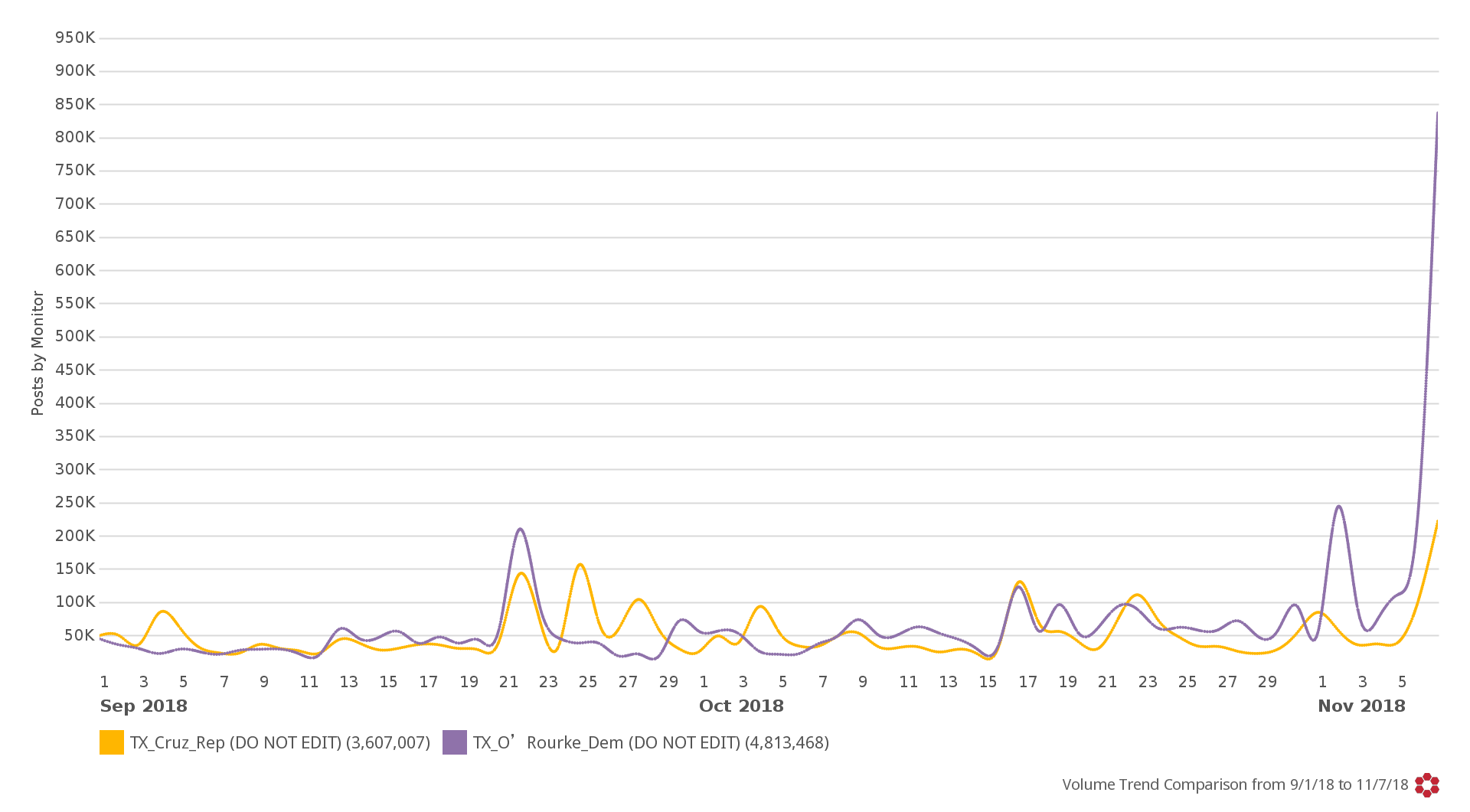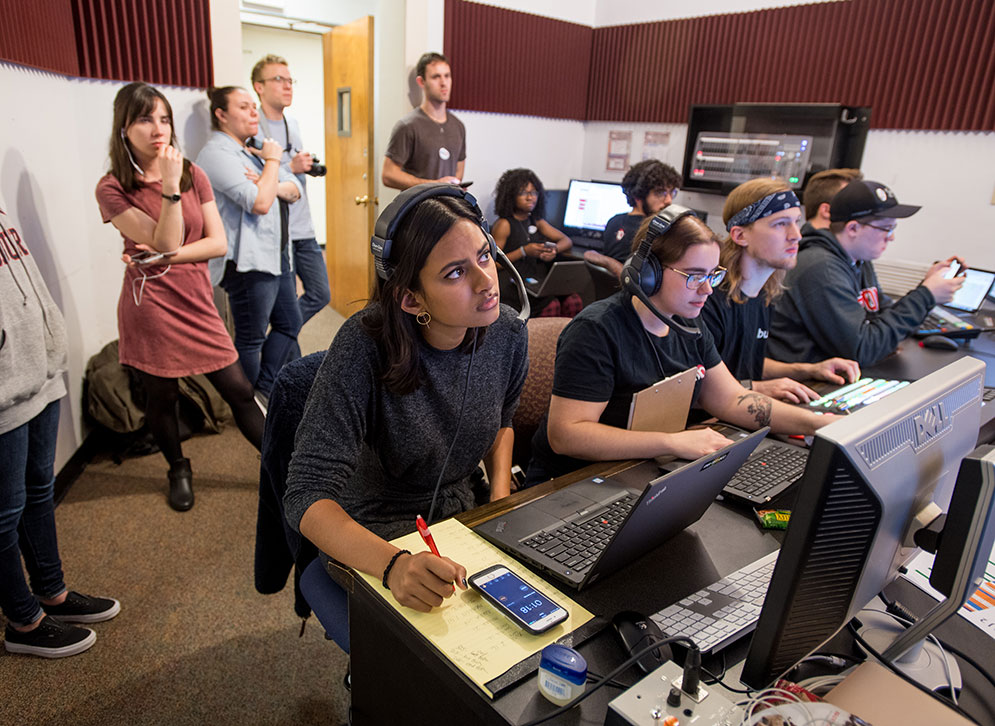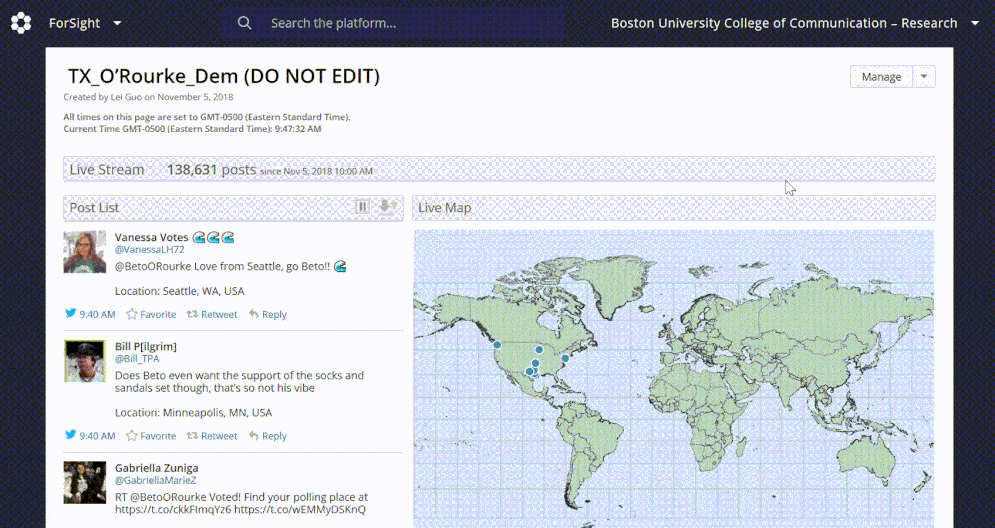What Does Social Media Sentiment Reveal about an Election?
COM students provide all-day coverage as faculty study candidates’ Twitter popularity
It’s nearly 5:30 pm on election night and Susan Walker, a College of Communication associate professor of journalism, calls out, “We’re nine minutes away from our live cut-in—do we have a mic check? Can you give me a 5-4-3-2-1?”
Adrian Thomas and Thomas Fiedler, dean of COM, count up and down, preparing for their first on-camera segment of the evening. Wolf Blitzer looms behind them on a giant monitor mounted to the wall of the Zimmerman Family Social Media Activation Center—the BU News Service’s election-night newsroom for the 2018 midterms.
COM students take Election Day seriously. Reporters started tweeting from polling places at 8 am and were still tweeting from candidates’ victory speeches as midnight approached. They produced hours of live television from the BUTV10 studio and discussed local and national issues all evening on WTBU. Students even provided the reporting for local newspapers, like the Cambridge Chronicle. And new for 2018, a small group of faculty members attempted to determine what Twitter traffic might reveal about election outcomes.

While students edit stories filed by reporters in the field and professors wait for video clips to arrive in their inboxes, most of the action is in the center of the room, where two bright lights and a camera focus on Thomas and Fiedler.
“OK—one minute away,” Walker (GRS’09) calls. The bustling room goes silent. Editors and bloggers stop typing. Someone mutes CNN. Voices hush.
“All right, stand by—10 seconds.” Walker counts the final moments with her fingers, points to camera operator Sarah Rappaport (COM’19), and COM’s election coverage is off and running. “Hello and welcome to the BU News Service coverage of the midterm elections,” Thomas says to the camera, before turning to Fiedler for an explanation of the night’s experiment.
“We’re using social media—and specifically Twitter—as a proxy of some kind to try and get a sense of how the electorate is feeling,” Fiedler explains. “This all comes out of the language that they’re using when they’re posting tweets.” That sentiment analysis is performed by a program called Crimson Hexagon, which filters tweets that fit preselected categories—in this case, Senate candidates from hotly contested seats in Arizona, Florida, Missouri, North Dakota, and Texas—and categorizes the sentiment expressed, on a spectrum from “joy,” through “surprise,” “disgust,” and “anger,” all the way to “fear.” What Fiedler and his colleagues hope to learn is whether filtering social media analytics in this way might mimic—or even improve upon—exit polls.

A graph produced with Crimson Hexagon software shows how often Beto O’Rourke, the Democrat in the Texas Senate race (purple), and Ted Cruz, the Republican incumbent (yellow), were mentioned on Twitter in the two months prior to the 2018 midterm election. Chart courtesy of Lei Guo (via Crimson Hexagon software)
“We’ll get a sense of energy. Intensity. Just from the size and the volume,” Fiedler adds. And then he and Thomas launch into several minutes of analysis of the Texas Senate race between Republican incumbent Ted Cruz and Democrat Beto O’Rourke.
Off camera, Walker and Lei Guo, a COM assistant professor of emerging media studies, monitor graphs, charts, and word clouds, toggling between screens as Fiedler and Thomas break down the Texas race, from the recent spike in tweets as Election Day approached, to a Jim Carrey tweet comparing Ted Cruz to a vampire. That tweet “may distort some of the findings we have here,” Fiedler says. After all, the engagement of even a few of Carrey’s 18.3 million followers could sway the sort of analysis going on in the Zimmerman Center.
“OK—clear!” Walker calls out as the segment ends. The room breaks into applause. “Hey, that was fun,” someone calls out.
Two floors above, a more traditional effort is underway. More than 50 students scramble into position for BUTV’s first live segment of the evening. Advisor Chris Cavalieri (COM’81), a COM assistant professor of television, hangs back and watches the production team prepare. “These kids are taking this up a notch,” he says. Naba Khan (COM’20), coproducer for the evening, started talking to Cavalieri about election night last May when she was interning at NBC’s Meet the Press. They’ve been discussing election night ever since. “I’ve been dreaming of producing one of these shows since 2016,” she says. “It was such an adrenaline rush.”

Coproducer Naba Kahn (COM’19) (seated, left, wearing headset) and director Marissa Dianas (COM’19) (seated, right, in headset) coordinated a team of more than 50 BUTV students during an ambitious election-night broadcast. Photo by Cydney Scott
Khan and director Marissa Dianas (COM’19) sit next to each other, talking into headsets and cell phones simultaneously, conducting an orchestra of cameras, video clips, and sound. On the other side of the control room door, red, white, and blue lights shine down on the evening’s hosts, Josee Matela (CAS’20, COM’20) and Nick McCool (COM’20). The end result is an evening of live studio shots, precut interviews and news stories, students reporting from Texas and Maine, and a two-hour live segment of analysis. “Even the networks don’t go live for that long,” Cavalieri says.
Back in the Zimmerman Center, Thomas welcomes viewers to another segment on Facebook Live. Results have begun coming in, and as polls anticipated, Democratic incumbent Heidi Heitkamp trails Republican challenger Kevin Cramer in North Dakota. “Look at that spike early on,” Fiedler says, pointing to a graph showing an early-October jump in Twitter activity mentioning Heitkamp—exactly when she announced that she would vote against the nomination of Brett Kavanaugh for the Supreme Court.
But then he notes an important caveat: those tweets were mostly coming from California, Florida, and Texas—and they were mostly positive. Crimson Hexagon labeled 42 percent of them as expressions of “joy,” with just 4 percent equating to fear or anger. “These races have been nationalized,” Fiedler says. “Typically the midterms have been about the state or local districts—not in 2018.” Sure enough, that out-of-state popularity means little and Cramer eventually wins by more than 10 percent.
BU News Service analyst Adrian Thomas and Dean of the BU School of Communication and election analyst Tom Fiedler to discuss the latest midterm results. Posted by Boston University News Service on Tuesday, November 6, 2018
Fiedler and Thomas break down the North Dakota Senate race between incumbent Democrat Heidi Heitkamp and Republican Kevin Cramer.
Relying on tweets for analysis poses a number of risks, and Fiedler highlights some of those on camera—primarily they’re looking at a global stream of information for state and local elections. Another risk goes unmentioned: how many of the tweets aren’t coming from real people? After the much-publicized spread of misinformation during the 2016 campaign, Twitter has made some attempts to combat these issues, taking steps to eliminate automated accounts (so-called “bots”) heading into this year’s election and making an effort to verify political affiliation claims of other accounts. Embracing the experimental nature of COM’s election-night plans, Fiedler theorized that given enough tweets, the noise created by fake accounts should be drowned out. “It’s to be seen whether someone could come, and in effect, point that stream,” he said. “I don’t think so—but we’ll see. It would be an interesting story if we found you can.”
On Wednesday morning, Guo took a look at how final results compared to her analytics. Both tweet volume and positive sentiment had favored Republican Josh Hawley, who defeated incumbent Claire McCaskill in Missouri. That pattern held with Republicans Rick Scott in Florida and Martha McSally in Arizona, both of whom held slim margins in those too-close-to-call races. In North Dakota, Democrat Heidi Heitkamp was the subject of more tweets than her opponent, Kevin Cramer, but had a higher “negative” percentage and lost the election.

The most interesting race continued to be Texas, where the results contradicted those trends. All of the “sentiment” metrics favored Beto O’Rourke over Ted Cruz, yet O’Rourke still lost. Thomas and Fiedler were in BUTV10’s studio at 11 am Wednesday to discuss that race. “What we saw with Beto O’Rourke was the intensity of the support for him,” Fiedler says, citing over 4.7 million tweets in the campaign’s final two months—26 percent of those expressing positive sentiment. Cruz, by comparison, appeared in 3.5 million tweets—almost 40 percent of those categorized as negative sentiment. In a state that hasn’t elected a Democratic senator since the 1980s, O’Rourke came within 3 percentage points of winning and received one million more votes than Cruz’s last Democratic challenger.
“If I was in the Beto O’Rourke camp, there was a lot here to take away, in a positive sense,” Fiedler says. “This election captivated people in Texas in a way that we have not seen in decades.” Those positive indicators, he theorized, could point to an O’Rourke campaign for an even higher office in two years.
While much could happen between now and then, COM will be there to cover it from all angles.
Marc Chalufour can be reached at mchalu4@bu.edu.

Comments & Discussion
Boston University moderates comments to facilitate an informed, substantive, civil conversation. Abusive, profane, self-promotional, misleading, incoherent or off-topic comments will be rejected. Moderators are staffed during regular business hours (EST) and can only accept comments written in English. Statistics or facts must include a citation or a link to the citation.